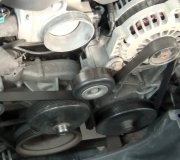Thanx Quagmire86
I only replaced the pads, rotor and caliper on the right rear, not the left. Would the left side being semi worn and glazed cause the uneven braking pressure and cause the overheating on the right side?
There are parking brake shoes inside the rotor but they looked fine and I dont think they are a problem as they are not used and they dont seem to be in contact with the rotor "drum" when I take the rotor on and off.
I would think the new caliper on the right side would have enough lub and seems to me that it slides well enough but I can take the pins off and relube them to be sure.
It seemed odd the pads on the inside wore out to the metal and the outside ones only wore out about half way
Could it be there is still some air in the caliper and as it heats up it adds pressure to that caliper? Just a shot in the dark.
Any more suggestions would still be appreciated
Sunday, October 18th, 2009 AT 8:36 PM



